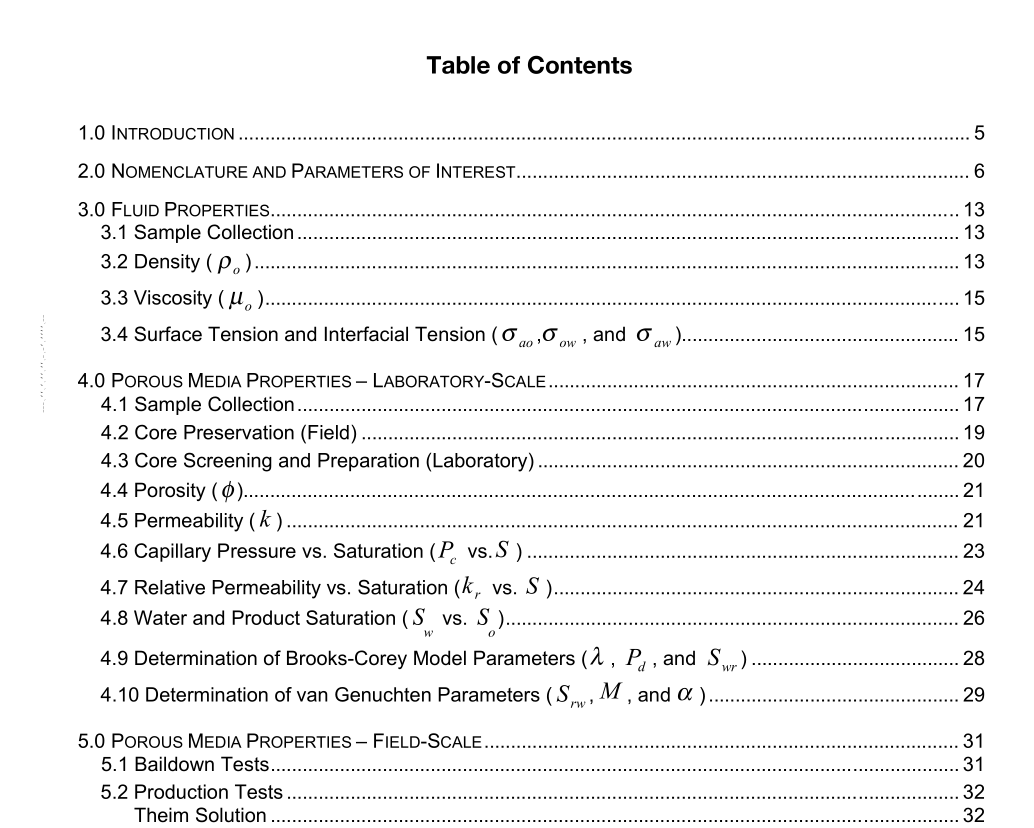API PUBL 4711 pdf download

API PUBL 4711 pdf download.Methods for Determining Inputs to Environmental Petroleum Hydrocarbon Mobility and Recovery Models
3.1 Sample Collection
Analysis of product properties begins with obtaining representative product samples. Typically this is accomplished by bailing free product from monitoring wells or collecting samples from active free-product recovery systems. Samples should be collected from a sufficient number of points to characterize the product present. Spatial variations in product properties commonly occur due to releases of different products and/or differential in situ weathering. A minimum volume of 250 mL of product (free of water) should be collected. Samples should be stored in brown glass containers with minimal head space and kept cool. No preservatives are required. In all cases the in situ temperature of the product should be determined. This reflects the dependence of fluid properties on temperature. In the case of bailed product samples, temperature should be measured immediately after collection. In the case of active recovery systems, the temperature should be measured in fluids that are ÒfreshÓ from the well (as opposed to stagnant fluids from piping or tanks). A third option is to lower a thermometer in a secure housing down a well to the water table. In all cases the thermometer should have a minimum accuracy of 1-degree Celsius. After sources of representative product samples have been identified, additional product and water samples should be collected for laboratory core studies. The volume of water and product needed to conduct core studies should be determined by asking the laboratory. Again, samples should be stored in brown glass containers with minimal head space and kept cool.
4.1 Sample Collection
Sediments – Analysis of soil properties at a laboratory scale begins with obtaining representative soil samples. Ideally, soil samples should be undisturbed. This reflects the fact that parameters of interest are dependent on the geometry of pore bodies and throats. Preservation of these features or reproducing these features represents a significant challenge. At one extreme, soil samples can be recovered using hollow stem auger and split spoon sampling equipment [see ASTM D1586-99 or ASTM D1452-80(1995)e1]. After extraction of product, samples can be dried and sieved to remove larger materials (e.g., gravel) that would block flow in a standard core holder (diameters of a few centimeters). Lastly, samples can be placed in coreholders with confining pressure similar to the in situ overburden pressure. The assumption associated with this approach is that the procedure will result in pore bodies and throats representative of the in situ conditions. In general, this approach should be avoided when possible due to potential biases associated with disturbing the architecture of the sediments. Alternatively, soil samples can be collected in liners. This can be accomplished using hollow stem auger drilling systems equipped with continuous sampling systems or using direct push drilling systems (see ASTM D6282-98) or thin-walled sampling tubes (see ASTM D1587-94). The liners serve as core preservation systems. Immediately after recovery the core should be frozen on site. This has been accomplished using liquid nitrogen or dry ice. Assuming the pore space is fully saturated with water (worst case), this will effect an approximate 5 percent expansion of the pore space. This may fracture the plastic sleeve. Even if this occurs, it is hoped that the general geometry of the particles will be preserved. Note: further complication is added by the fact that petroleum liquids shrink at reduced temperatures. Methods outlined by Durnford et al., (1991) or Murdoch et al., (2000) hold promise to overcome the noted biases. Unfortunately, their availability and effectiveness is not well documented. Alternatively, using conventional equipment, samples should not be collected from below the water table as this limits fluid flushing through the sample. In addition, core lengths should be less than the height of capillary rise in the soil of interest. This will limit drainage of liquids from the samples as they are collected. McWhorter (1996) describes an empirical approach to estimating air-water displacement pressure. Using this method and the assumption that only water liquid is present in the pore space, estimates of capillary rise (maximum sample height) as a function of sediment hydraulic conductivity can be obtained (See Figure 5).









